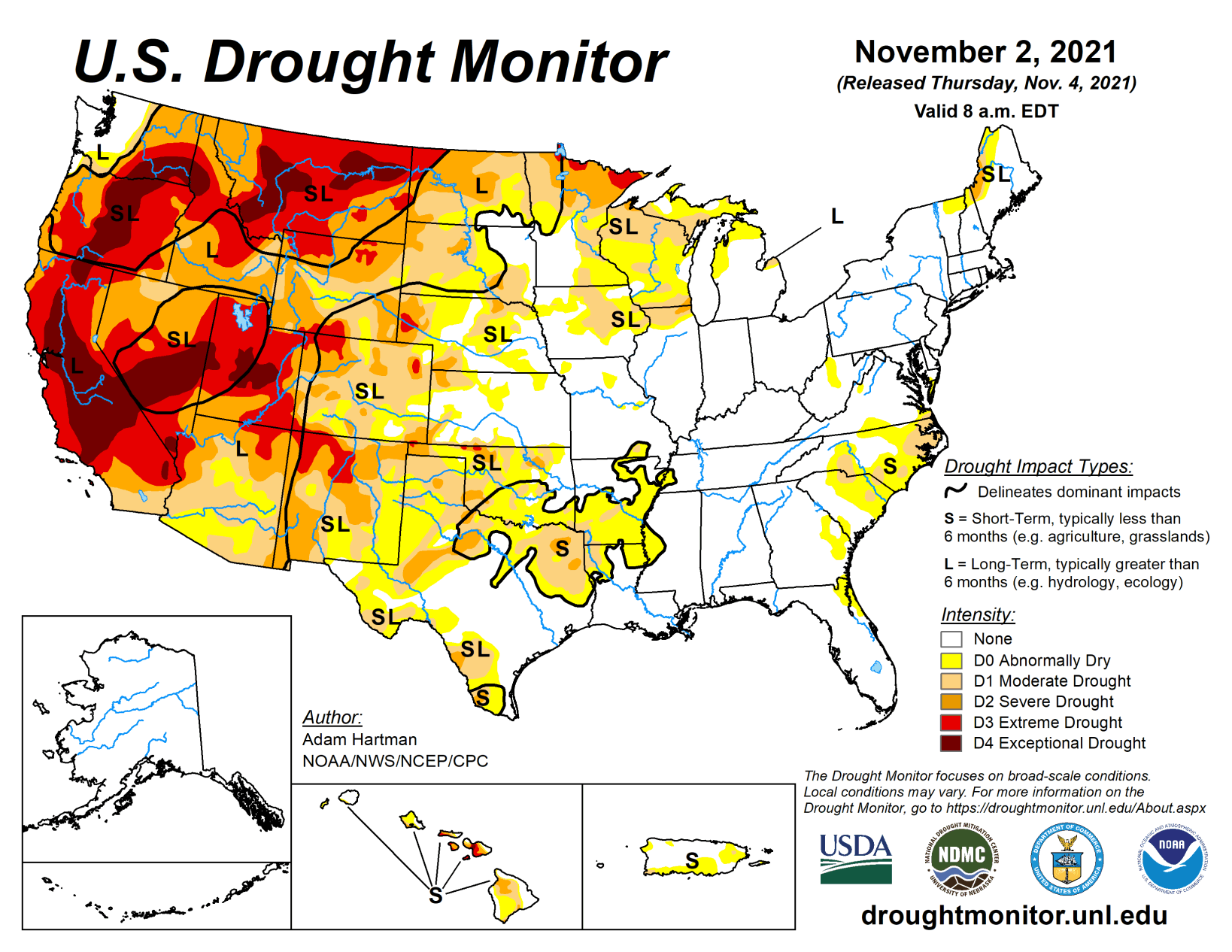This week, a low pressure system slowly moved eastward across the eastern contiguous U.S. bringing heavy rainfall to many areas from the Mississippi Valley to the East Coast. Parts of the Central Plains, Gulf Coast, Northeast, and Mid-Atlantic saw over 2 inches of rainfall.
Improvements were warranted where the heaviest precipitation fell across parts of the Central and Northern Plains, the Corn Belt, and northern New York and New England. Conversely, areas that missed out on adequate precipitation across the western Great Lakes and the Carolinas experienced degradation of ongoing abnormally dry and drought conditions, exacerbated by above-normal temperatures and increased evaporative demand. Across the western CONUS, an active storm track in the Pacific Northwest resulted in another week of improvements from Washington to northwest Montana. Soil moisture indicators continue to improve across much of the Western Region, leading to some localized improvements, but for most areas, long-term deficits remain intact and groundwater and reservoir levels remain well below-normal.
Additionally, it is too early in the season for solid snowpack to build across many areas. Some localized degradations were warranted in Montana, east of the Front Range, and in the Southern Plains, as above-normal temperatures and high wind events have helped to worsen ongoing drought in those areas.
South
Rainfall amounts, associated with a slow-moving low pressure system traversing the eastern half of the Southern Region (eastward from Arkansas and Louisiana) were just enough to warrant a status quo depiction this week. Conversely, rainfall from this same low pressure system early in the week was heavy enough to warrant improvements across much of eastern Oklahoma, where many locations received more than 150 percent of normal precipitation for the 7-day period. Farther south, in eastern Texas, 7-day precipitation was below-normal, despite 0.5-1 inch of rainfall across a large region experiencing moderate (D1) to severe (D2) drought. Above-normal temperatures and high winds associated with the exiting low pressure system resulted in increased evaporative demand across much of eastern Texas.
Despite the rainfall, there was even a report of a wildfire near Rusk County, Texas. Farther west across the Southern High Plains, conditions also deteriorated, resulting from D1 to D3-equivalent 30-90 day Standardized Precipitation Indices, widespread NASA SPoRT soil moisture rankings below the 10th percentile (below the 5th percentile at shallower depths for many locations), below-normal precipitation, and above-normal temperatures (2 to 6 degrees F above-normal).
Midwest
The Midwest experienced temperatures ranging from 2 to 8 degrees F above-normal, with the greatest positive anomalies in the Great Lakes region. Despite the unseasonably warm temperatures, heavy precipitation in excess of 1.5 inches led to 1-category improvements in areas experiencing abnormally dry (D0) and drought (D1-D3) conditions across much of the western Midwest Region from Minnesota southward to Missouri. However, in the western Great Lakes, precipitation was lacking this week, warranting additional expansion of D0 (abnormal dryness) and D1 (moderate drought) across northern Wisconsin and Michigan. In addition, these areas are experiencing D1 to D3-equivalent SPIs over the past 60 days and soil moisture has fallen below the 20th percentile for many locations. Stream flows are also beginning to fall, but remain within normal ranges for most areas (between the 25th and 75th percentile).
High Plains
Many locations across the High Plains Region experienced improvement in drought conditions this week, from eastern Kansas and Nebraska northward, and westward to the northern Front Range. In eastern portions of the High Plains, above-normal precipitation in excess of 1.5 inches for several areas led to 1-category improvements. This region has also benefited from improved soil moisture in recent weeks as the storm track remained active during October. Across the western Dakotas and parts of Wyoming, improvements were also warranted, despite rainfall lacking for many locations, as drought indicators have continued to improve due to many locations receiving over 200 percent of normal precipitation since the beginning of October. Soil moisture and short-term rainfall deficits are much improved for most areas. However, while ground reports corroborate the improved soil conditions, they also indicate that rangeland conditions are slow to recover and stock ponds remain below-normal with poor water quality, indicative of longer-term hydrologic deficits. Along the southern Front Range, above-normal temperatures and below-normal precipitation resulted in further degradation, as evaporative demand has remained high, exacerbated by high winds.
West
An active storm track across the Pacific Northwest and northern California has resulted in improving conditions during October, with improvements in northern California and the central Great Basin being attributed mainly to the strong atmospheric river event in late October, which dropped record 24-hour precipitation in several locations. This week the active storm track persisted, leading to improvements across parts of western Washington and the interior Pacific Northwest.
Soil moisture has and stream flows have improved greatly for many areas in the central and northern Great Basin, warranting some improvements across southern Idaho, northeastern Nevada, and northern Utah. However, groundwater and reservoir levels are slow to respond and will need continued above-normal precipitation this season to recharge. Snowpack has started to build across the northern Rockies and the Cascades, and even into parts of the Sierra Nevada, but it is still early in the season to reap the benefits. D4 (exceptional drought) expansion was warranted in central Montana, as stream flows have fallen below the 2nd percentile, NASA SPoRT and CPC soil moisture have fallen below the 2nd percentile, vegetation indices show increased stress, and 30-60 day SPIs have fallen to D4 levels. In addition, parts of this new D4 area have experienced a record dry period spanning September to October. The timing of this dryness has also stunted winter wheat growth in the region. Status quo was warranted elsewhere in the West as antecedent 30-day wetness and improved soil moisture offsets the observed above-normal temperatures for the 7-day period.




